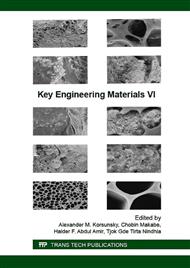[1]
Q. Fu, Y. Men, G. Strobl, Understanding of the tensile deformation in HDPE/LDPE blends based on their crystal structure and phase morphology, Polymer 44 (2003) 1927-(1933).
DOI: 10.1016/s0032-3861(02)00940-0
Google Scholar
[2]
K. Cho, B.H. Lee, K. Hwang, H. Lee, S. Choe, Rheological and mechanical properties in polyethylene blends, Polym. Eng. Sci. 38 (1998) 1969-(1975).
DOI: 10.1002/pen.10366
Google Scholar
[3]
I. Jakubowicz, N. Yarahmadi, H. Petersen, Evaluation of the rate of abiotic degradation of biodegradable polyethylene in various environments, Polym. Degrad. Stab. 91 (2006) 1556-1562.
DOI: 10.1016/j.polymdegradstab.2005.09.018
Google Scholar
[4]
P.K. Roy, S. Titus, P. Surekha, E. Tulsi, C. Deshmukh, C. Rajagopal, Degradation of abiotically aged LDPE films containing pro-oxidant by bacterial consortium, Polym. Degrad. Stab. 93 (2008) 1917-(1922).
DOI: 10.1016/j.polymdegradstab.2008.07.016
Google Scholar
[5]
G.L. Leuterio, B. Pajarito, Sorption kinetics of pro-oxidant-loaded PE plastic bags in aqueous media, Adv. Mat. Res. 1125 (2015) 240-244.
DOI: 10.4028/www.scientific.net/amr.1125.240
Google Scholar
[6]
R. Maalihan, B. Pajarito, Effect of colorant on tensile strength and carbonyl index of oxo-biodegradable low-density PE films during thermal aging, Adv. Mat. Res. 1125 (2015) 235-239.
DOI: 10.4028/www.scientific.net/amr.1125.235
Google Scholar
[7]
J.R. Jambeck, R. Geyer, C. Wilcox, T.R. Siegler, M. Perryman, A. Andrady, R. Narayan, K.L. Law, Plastic waste inputs from land into the ocean, Mar. Pollut. 347 (2015) 768-771.
DOI: 10.1126/science.1260352
Google Scholar
[8]
L.B. Gomes, J.M. Klein, R.N. Brandalise, M. Zeni, B.C. Zoppas, A.M.C. Grisa, Study of oxo-biodegradable polyethylene degradation in simulated soil, J. Mater. Res. 17 (2014) 121-126.
DOI: 10.1590/1516-1439.224713
Google Scholar
[9]
J.L. Pablos, C. Abrusi, I. Marín, J. López-Marín, F. Catalina, E. Espí, T. Corrales, Photodegradation of polyethylenes: Comparative effect of Fe and Ca-stearates as pro-oxidant additives, Polym. Degrad. Stab. 95 (2010) 2057-(2064).
DOI: 10.1016/j.polymdegradstab.2010.07.003
Google Scholar
[10]
R.D. Maalihan, B.B. Pajarito, Effect of colorant, thickness, and pro-oxidant loading on degradation of LDPE films during thermal aging, J. Plast. Film Sheet. 8756087915590276 (2015).
DOI: 10.1177/8756087915590276
Google Scholar
[11]
A. Benítez, J.J. Sánchez, M.L. Arnal, A.J. Müller, Monitoring abiotic degradation of branched polyethylenes formulated with pro-oxidants through different mechanical tests, Polym. Degrad. Stab. 98 (2013) 1705-1716.
DOI: 10.1016/j.polymdegradstab.2013.06.004
Google Scholar
[12]
B. Pajarito, C. A de Torres, M. Maningding, Effect of ingredient loading on surface migration kinetics of additives in vulcanized natural rubber compounds, Sci. Diliman 26 (2014) 1-35.
Google Scholar
[13]
B. Pajarito, Effect of ingredient loading on vulcanization characteristics of a natural rubber compound, Adv. Mat. Res. 1125 50 (2015) 50-54.
DOI: 10.4028/www.scientific.net/amr.1125.50
Google Scholar
[14]
J. Arabit, B. Pajarito, Effect of ingredient loading on surface migration of additives in a surfactant-loaded natural rubber vulcanizate, Adv. Mat. Res. 1125 (2015) 64-68.
DOI: 10.4028/www.scientific.net/amr.1125.64
Google Scholar
[15]
J. M. Gere, Mechanics of Materials, sixth ed., Thomson, California (2004).
Google Scholar
[16]
D.M. Panaitescu, C. Radovici, M. Ghiurea, H. Paven, M.D. Iorga, Influence of rutile and anatase TiO2 nanoparticles on polyethylene properties, Polymer Plast. Tech. Eng. 50 (2011) 196-202.
DOI: 10.1080/03602559.2010.531431
Google Scholar
[17]
V.M. Tuan, D.W. Jeong, H.J. Yoon, S. Kang, N.V. Giang, T. Hoang, T.I. Thinh, M.Y. Kim, Int. Using rutile TiO2 nanoparticles reinforcing high density polyethylene resin, J. Polym. Sci. 2014 (2014) 1-7.
DOI: 10.1155/2014/758351
Google Scholar
[18]
J. Yang, Z. Jin, X. Wang, W. Li, J. Zhang, S. Zhang, X. Guo, Z. Zhang, Study on composition, structure and formation process of nanotube Na2Ti2O4(OH)2, Dalton Trans. (2003) 3898-3901.
DOI: 10.1039/b305585j
Google Scholar


